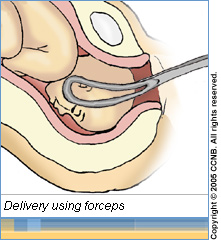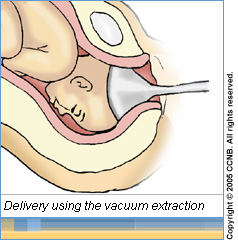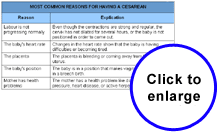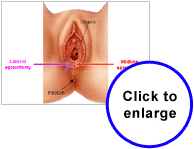MODULE 7
Healthy Birthing
e. Forceps and Vacuum Extraction
Certain women may need help to get the baby out quickly, for example, if the baby's heartbeat slows down or becomes irregular, or if the baby is in a position that makes birth difficult, or if you are just too tired to push anymore.
When this happens, your health care provider will give you a local anesthesia , do an episiotomy, and use the forceps or vacuum extraction.
Forceps are shaped like spoons and are placed on either side of the baby's head to gently ease the baby out.

The vacuum extraction method is when a soft plastic cap is placed on the baby's head and gentle suction eases the baby out.

Both the forceps and the vacuum extraction leave marks on the baby's head. These marks are not serious and soon disappear.
f. Cesarean Birth
A cesarean section, which is an operation, is performed when giving birth through the vagina is not safe for the baby. Even though you may be planning for a vaginal birth, it's a good idea to learn about cesareans in case your baby needs to be born this way.
A cesarean birth may be planned ahead of time or decided upon during delivery because of unexpected difficulties.
Here are the most common reasons for having a cesarean birth:
If you do need a cesarean birth, it is important that both you and your partner are involved in the decision. Needing a cesarean birth does not mean that you have failed in any way. The overall goal is to have a healthy mother and a healthy baby. Sometimes the cesarean birth is the only way to achieve this goal.
Depending on the hospital and the reason a cesarean birth is performed, you may need an epidural anesthesia , a spinal anesthesia or general anesthesia . In certain cases, your partner may stay with you while in other cases, he will be asked to leave the operating room.
The following images will help you visualize how a cesarean birth is performed.
After a cesarean birth, the baby will get special attention from the doctors and nurses. The baby will be wrapped in a warm blanket and given to you and your partner to hold.
Most mothers find that it takes them longer to recover from a cesarean birth than from a vaginal birth. This is because after a surgery, recovery takes more time.
d. Episiotomy
An episiotomy is an incision made between the vagina and the rectum (midline episiotomy) or off to one side ( lateral episiotomy) to make more room for the baby to pass through. An episiotomy is usually done right before the baby is born. A local anesthesia is used before the episiotomy is done.
After the baby and the placenta are out, the episiotomy is sewn up with dissolving stitches.
Usually doctors will do an episiotomy only when absolutely necessary, for example, during a forceps delivery or if there is difficulty pushing the baby's head out. Talk with your health care provider if you want more information.
c. Pain Relief
For many women, the breathing, relaxation, and comfort positions you have practiced during your pregnancy will be all you need during labour. However, some women find that these alone are not enough, and they need other kinds of pain relief.
Having a trusted support person with them throughout labour has been shown to help women manage labour pain better.

Different types of pain relief are available depending on where you deliver your baby. Talk to your health care provider during your prenatal visits to find out what is available.
The following table presents the different types of pain relief that can be used to relieve the pain during labour.
b. Fetal Monitoring
Fetal monitoring is a way to check on the well being of the baby during labour.
There are several different kinds of fetal monitoring. The type of monitoring you will receive will depend on the nursing staff, the hospital's equipment, and whether or not you have any complications. If the pregnancy is normal and without complications, it is possible to use a technique that will allow you to move around.
Here are the main fetal monitoring techniques that may be used during labour.
C. MEDICAL HELP DURING CHILDBIRTH
Most births are normal and uncomplicated. However, no matter how well you prepare, there is no guarantee that everything will go as you planned.

Ask your health care provider questions now. If you need medical help during labour, you will be prepared to make choices that are right for you and your baby.
a. Induction
Few women have their babies exactly on their due date. Pregnancy usually lasts between 38 and 42 weeks but there are exceptions. If you do not begin your labour around this time, your health care provider will watch you carefully.
Labour is induced for specific reasons which may include:
- The mother has a medical problem such as heart disease, diabetes, or high blood pressure.
- The baby has a medical problem and must be born sooner.
- Your health care provider decides that your pregnancy has lasted longer than is safe for you or your baby.
- Your waters have broken, but labour has not started.
Labour can be induced using different methods such as: stripping the membranes , cervical ripening , artificial rupture of membranes , and induced contractions .
Discuss with your health care provider if you have additional questions about induced labour.
5. Breathing While Pushing
Once your cervix is fully open, your health care provider will ask you to push when you feel the urge. This may occur several times during each contraction.
When a contraction begins, take a relaxing breath - in through your nose or mouth and out through the nose or mouth.
Practice any breathing technique that is comfortable until you feel the urge to push.
When you feel the urge to push:
- Relax your pelvic floor muscles.
- Tuck in your chin and curl your trunk forward.
- Tighten lips and breathe out very slowly.
- Continue breathing until the urge to push leaves.
There are other methods of breathing while you push. Your health care provider may suggest a different one at delivery time. Use the method that works best for you.

h. Practicing for Labour
A labour rehearsal is a chance for you and your partner to put together all the new techniques you have learned.

During the rehearsal, your partner talks you through imaginary contractions. Your role is to practice breathing and relaxation methods in time with these imaginary contractions. Your partner must also check to be sure that you are relaxed. If you are tense, gentle stroking or touching can help you relax.
You can also follow "Your Guide to Labour and Delivery" found further on in this module to help connect your labour rehearsal to the real thing.
4. Breathing to Help You Stop Pushing
At certain moments during labour, you will feel the urge to push, but your health care provider may ask you NOT TO PUSH.
 for a description of the breathing technique to help you stop pushing.
for a description of the breathing technique to help you stop pushing.
 to hear the breathing technique to help you stop pushing.
to hear the breathing technique to help you stop pushing.
You can practice breathing to stop pushing. While you are practicing your pant-blow breathing, have your partner say "urge to push." Switch to blowing out for a few seconds until your partner says "urge passes." Then return to pant-blow breathing.







